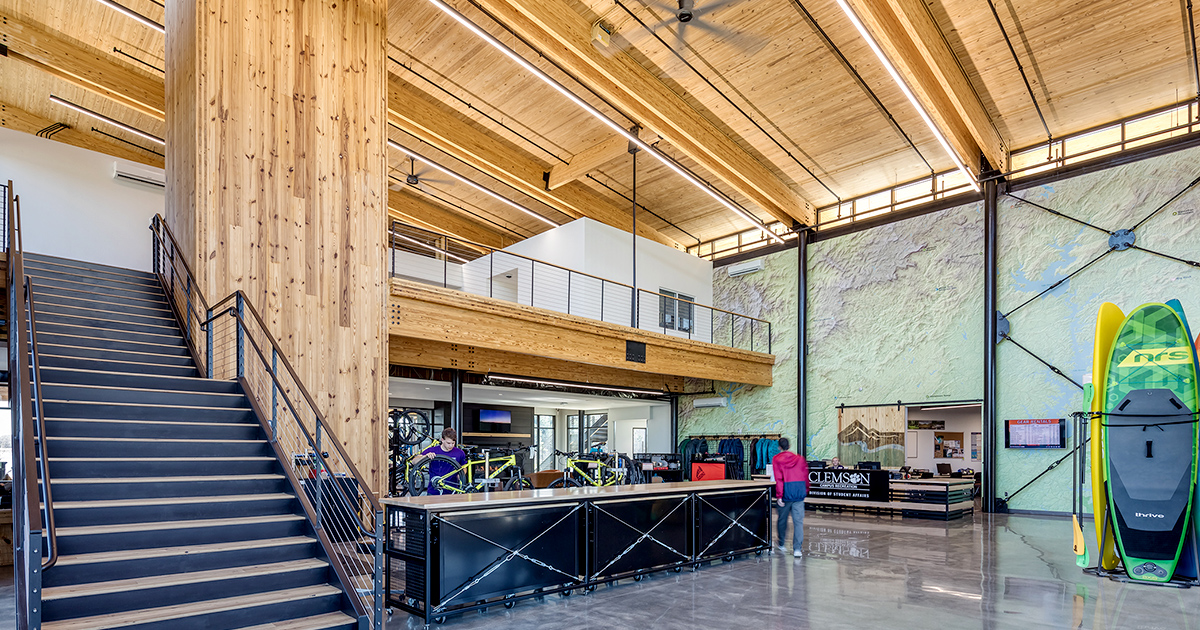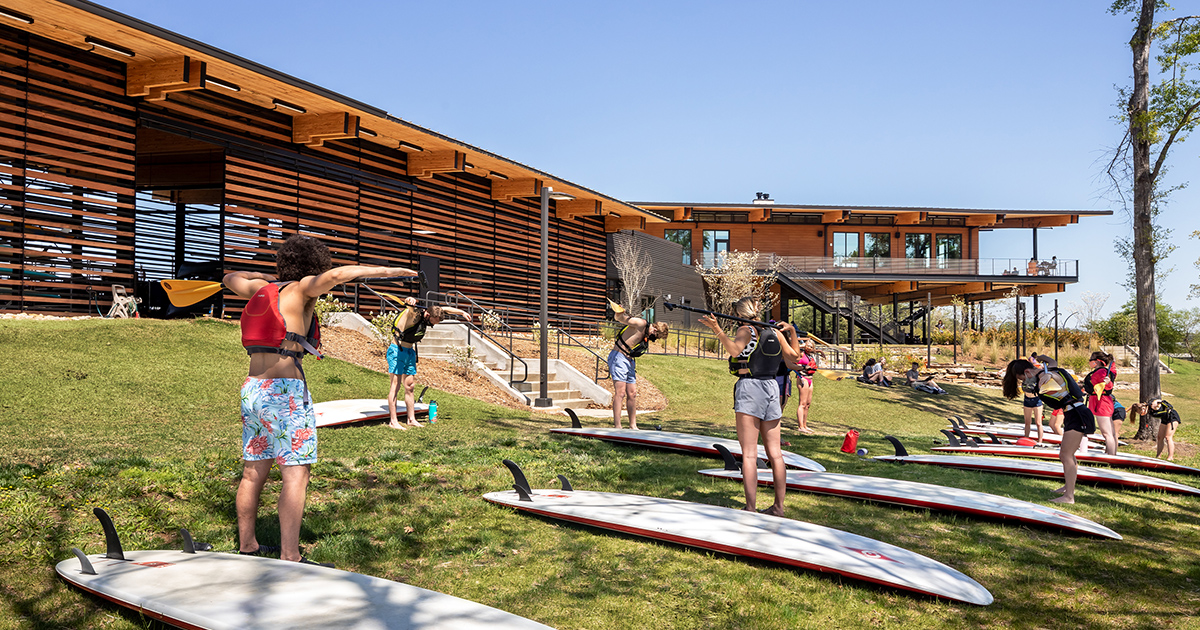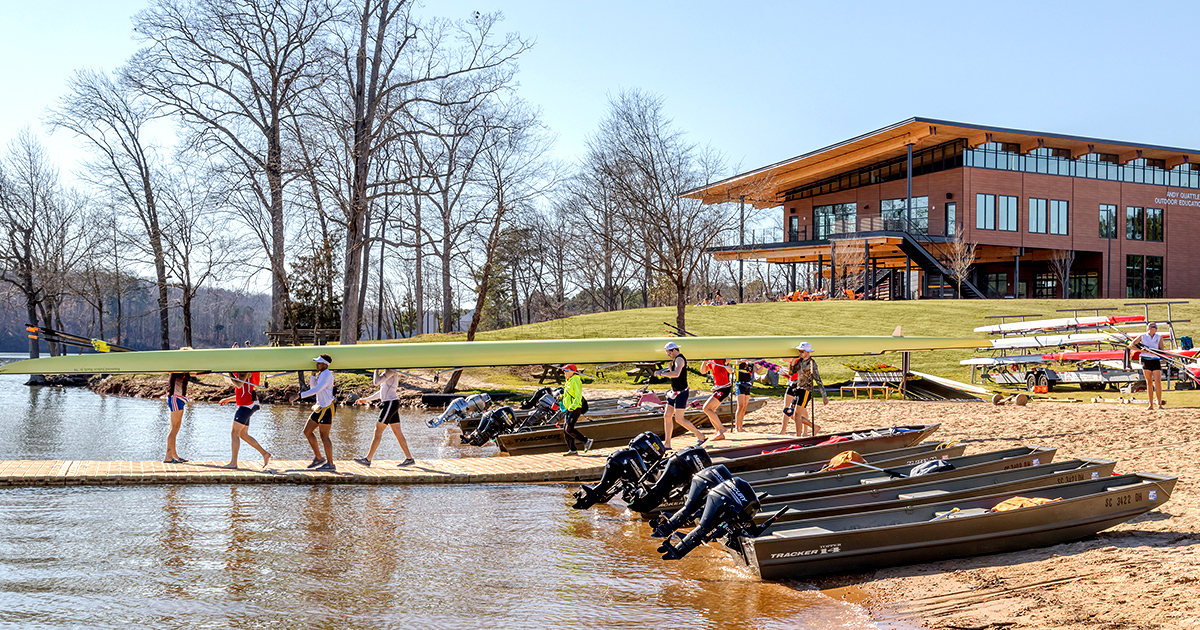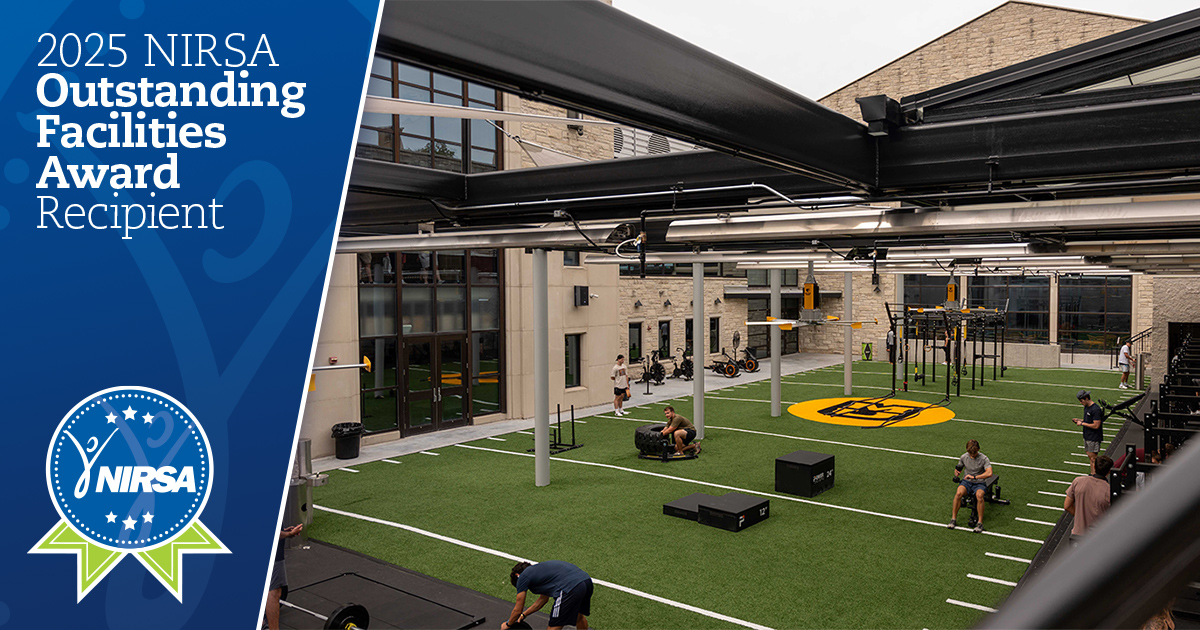Intelligent campus recreation facility design inspires student experiences that promote physical, emotional, and mental health. Outdoor rec facilities in particular can be incredible destinations for student connection, community, and physical activity. Exceptional outdoor rec facilities not only encourage students to actively engage with nature, but they also support taking the time to absorb what nature has to offer. They encourage students to relax. To just be in the moment.
The Andy Quattlebaum Outdoor Education Center at NIRSA member institution Clemson University has an innovative biophilic design that emphasizes wellness and relaxation while motivating students to explore the great outdoors. A second-of-its-kind building that emphasizes sustainability and aesthetic beauty, the “Andy’s” was honored with a 2022 NIRSA Outstanding Facilities Award.
It’s hard to imagine a better place for outdoor recreation than Clemson’s 1,400-acre campus, situated in the foothills of the Blue Ridge Mountains. One edge of the campus extends into the university’s 17,500-acre Experimental Forest, while the other rests on the waters of Lake Hartwell. Andy’s overlooks a finger of one of the Southeastern United States’ largest recreation lakes which borders Georgia and South Carolina and encompasses parts of the Savannah, Tugaloo, and Seneca rivers.
About the Andy Quattlebaum Outdoor Education Center at the Snow Complex
The cornerstone of Clemson’s Snow Family Outdoor Fitness and Wellness Complex, Andy’s is a 16,000-square-foot facility reminiscent more of a large cabin than a traditional campus structure. Multiple fireplaces, hanging chairs, and hammocks encourage students to relax near the lakefront and take in stunning views from the covered patio lounge or second-level deck.
Dedication to recreation
Natural light streams into the main lobby through the immense windows of the two-story building’s open atrium. Behind the welcome desk, a topographical map highlights a few of the region’s popular hiking, camping, biking, rafting, and fishing destinations.

The building design almost has the feel of a large outdoor retail store, which is appropriate as Andy’s is home to the Clemson Outdoor Recreation and Education (CORE) Program. CORE helps students develop a lifelong passion for the outdoors through a variety of trips, instructional programs, and outdoor adventure opportunities. The new facility allows CORE, previously housed in an old trailer and hog barn, to deliver upgraded service to students in a variety of ways:
- An open-air boathouse behind the Andy’s houses rentable kayaks, stand-up paddleboards, canoes, and whitewater rafting gear
- The outdoor equipment rental service gives students access to a multitude of gear from camping supplies to fishing rods, mountain bikes to rock climbing shoes, and frisbees to yard games
- A bike repair shop allows students to repair their own bikes and take clinics to hone their bike-maintenance skills
- The resource library serves as a travel planning hub with maps, guidebooks, and other resources for CORE’s many trips—skiing, rock climbing, hiking, sea kayaking, and more— and for students to plan their own outdoor adventures
- Two multi-purpose classrooms provide space for experimental learning (like backcountry cooking clinics), fitness classes (like yoga and aerobics), and workshops (like Wilderness First Aid Certifications and Leave No Trace)
Dedication to nature
CORE’s mission is reflected in the building itself. Andy’s aesthetic beauty blends with the surrounding landscape and incorporates elements like natural lighting and exposed wood, inviting students to connect with nature and inspiring involvement in outdoor activities.
This biophilic design is an architectural approach that emphasizes engagement with nature, is inspired by the natural world, and satisfies our innate need for immersion in the outdoors. The facility design itself positively impacts the physical and mental wellbeing of its occupants: Andy’s stirs an emotional connection to nature, sparking a drive for physical involvement in outdoor activities while evoking the rejuvenating and relaxing qualities of the natural world.
Dedication to sustainability
Andy’s also embodies Clemson’s commitment to sustainability and preservation, promoting environmental wellbeing in addition to student wellness. It’s a net-zero energy building with photovoltaic materials on its roofs allowing the facility to produce enough energy to offset its needs. Other sustainable elements include minimal cooling/heating, a vast glass façade for daylight with sensor-controlled lighting, and fans for passive cooling. Even more impressive and groundbreaking is Andy’s mass timber construction.
Clemson’s first mass timber facility, Andy’s is one of two facilities in the nation to use southern pine cross-laminated timber—a locally sourced and manufactured species. A strong, low-carbon alternative to concrete, mass timber systems contain a structural framing of glue-laminated timber beams. Combined with steel columns, this construction produces an expansive interior with fewer support elements and significantly reduced costs, requiring roughly 90% less construction traffic and 25% faster construction overall.

Andy’s features cross-laminated timber floors, roof slabs, and shear walls, and most of the interior wood structure remains exposed, creating visual warmth and emphasizing the building’s biophilic role. Piping, fire protection, electric, and other utility systems were precisely placed and painted to match the aesthetic of the facility’s interior steel elements.
Almost more captivating than the building itself is the fact that mass timber construction was pioneered, in part, by Clemson faculty and students. The university’s Wood Utilization + Design Institute (WU+D) championed the decision to build with mass timber and helped explore options for the school’s new facility. Beyond student recreation, Andy’s serves as a student research facility for mass timber construction and wood-based building solutions. It has inspired similar sustainable construction at other universities and helped grow and innovate South Carolina’s forest products industry.
Dedication to Andy
Andy’s origin story is as moving as the building itself. The facility, which opened in December 2019, was made possible by a $2.7 million gift from Don and Hayden Quattlebaum in memory of their son Donald Anderson “Andy” Quattlebaum Jr., who died by suicide at the age of 22 in March 2019. A Bridge to Clemson student, Andy was invested in wildlife conservation and outdoor activities like camping, hunting, boating, and rock climbing. He spent time at Y-Beach, which is now located across from the facility that shares his name and encapsulates many of his passions.
“Many of the things that Andy loved to do will be available to other students,” Don said at the building’s dedication in January 2020. “In this world, where there is a growing concern for the environment and man’s place in it, the more that people can learn about the outdoors, and participate in all that it has to offer, the better chance that they will make better choices in life about the world around us.”
About the lead architect
In Andy’s innovative design, it’s easy to identify lead architect Cooper Carry Architect’s legacy of good stewardship through sustainable design and inclusion. The development of the mass timber structure in tandem with Clemson students and faculty demonstrates the firm’s specialized and personal approach.

“I remember seeing the first sketches from Cooper Carry and how amazing it was,” said Dr. Patricia Layton, Director of the Wood Utilization + Design Institute. “I consider this Clemson’s finest front porch. I know Thomas Green Clemson would love to sit here and look back at his legacy and know that our university continues to develop and grow our economy and use our natural resources for the benefits of our state and nation. That was his vision, and that’s what he gave to us. This is the first building manufactured from southern yellow pine CLT east of the Mississippi River. It will be a place visited by millions in the years to come. It really is a dream come true to see this magnificent building come to fruition.”
Collaboration between key stakeholders was key to the project’s successful outcome. “We approach each project as a unique entity and recognize that our work is sometimes a reflection of a changing world and sometimes a herald of it, but that no matter what it is best approached with fresh eyes and an open mind,” Bran Campa, AIA, LEED AP, principal at Copper Carry says. “We’re known not to have a style, but to design each project precisely for our clients’ needs, the context of the location, and the delight of the end user.”
When it comes to university building design their work covers everything from residence halls and dining halls to science buildings, recreation centers, student unions, and everything in between. Founded in 1960, the firm is a “creative collective” that believes well-designed places can positively impact people’s lives.
About NIRSA’s Outstanding Facilities Awards
The annual NIRSA Outstanding Facilities Awards recognize the innovative designs of new, renovated, or expanded collegiate recreational facilities of NIRSA member institutions. Winning facilities are considered a standard by which other campus recreation facilities should be measured, and from which others can benefit.
Applications for the 2023 class of NIRSA Outstanding Facilities Award recipients are open through November 16. Eligibility guidelines, selection criteria, and entry fee details can be found on the NIRSA website.
- For more information, contact NIRSA Director of Membership Sarah Leskovec.







